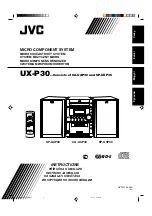
Manual-5
OPERATING INSTRUCTIONS
The MQ 302 is an accurate, professional quality instru-
ment capable of precise equalization down to a fraction of a
dB. You can expect several advantages from your constant-Q
equalizer over conventional designs: Moving one slider will
not affect neighboring filters as much, so you won’t spend
time re-adjusting sliders (we call this “equalizing the equal-
izer”). You’ll be able to obtain better feedback control
without losing sound quality. All sliders maintain smooth,
consistent and accurate calibrated control over filter levels,
which is especially critical in low-profile equalizer designs.
Because of this, the overall EQ adjustment process is signifi-
cantly easier and more effective.
Equalizing a sound system by ear is a
very
difficult
process to achieve successfully, especially in a timely
manner. Although the human ear is very sensitive, it is
not
calibrated, nor consistent, and frankly the odds
against
a well
behaved, clear sound system are very great when tuned by
ear. Most people know when a sound system doesn’t sound
good, unfortunately they just can’t tell exactly
why
and
where
it’s not right.
Because of this, we strongly recommend the
use of a realtime analyzer to properly equalizer your system
with the MQ 302.
Forget everything you’ve thought about analyzers and
consider this: there’s a newer generation of analyzers which
are compact, simple, very easy to operate and surprisingly
affordable. Best of all, they can make a drastic improvement
in the overall performance of your sound system while saving
you a great deal of time and effort.
A realtime analyzer helps you quickly achieve things
nearly impossible by ear: flatten speaker response, minimize
feedback, remove room resonance and allows accurate
crossover alignment. In most cases, simply “normalizing” or
“flattening” a sound system is a surprisingly drastic improve-
ment, but
don’t stop there
:
Remember this Rane proverb: “Look, don’t stop, and
listen.” Once you have aligned the system by
looking
at the
analyzer,
don’t stop
at this point.
Listen
to the music
program and make additional adjustments to suit your taste,
the type of music and your audience. Fatten the bass, sweeten
the highs, brighten the mids. Since you are starting from a
“tuned” system, your ear will not be fooled into thinking bass
is too high when actually mids are too low, or that highs are
too weak when really the mids are too strong.
Fact: analyzers don’t have good taste—people do.
Analyzers consistently and accurately “tell it like it is,” but
ultimately, personal judgment determines what sounds good
or appropriate. In fact, final optimum EQ settings, made
after
analyzer testing, will vary greatly depending on the type of
music, sound pressure level, size of the venue and disposition
of the audience.
Conclusion:
To consistently obtain the best sound from
your system, use an analyzer and then your ears, in that
order.
The analyzer supplies the consistency and calibration
while your ear supplies the good taste.
5,*+7
/2:+,*+
/()7
/2:+,*+
0212
68%:22)(5
0$,12873876
0,;(5
0&
67(5(2&2035(6625
04
67(5(2(48$/,=(5
0;
67(5(2:$<&526629(5
67(5(2$03+,*+
67(5(2$03/2:
0212RU%5,'*('$03021268%
Figure 1. Stereo Biamp System with Equalizer
Содержание MQ 302
Страница 9: ...Manual 9 VARIOUS XLR CABLE ASSEMBLIES ...




























